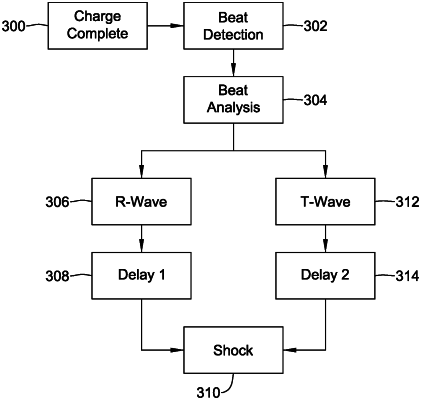| CPC A61N 1/3987 (2013.01) [A61N 1/3956 (2013.01); A61N 1/3981 (2013.01)] | 10 Claims |

|
1. A method of delivering a defibrillation shock in a defibrillator having electrodes for sensing cardiac signals, analysis circuitry for analyzing the sensed cardiac signals, therapy delivery capacitors for storing energy for the defibrillation shock, a charger configured to charge the therapy delivery capacitors, and therapy output circuitry for issuing the defibrillation shock using energy stored on the therapy delivery capacitors;
the method comprising:
determining a need for the defibrillation shock and charging the therapy delivery capacitors for defibrillation shock delivery to a predetermined shock threshold;
after completing charging of the therapy delivery capacitors to the predetermined shock threshold:
sensing an Nth cardiac electrical event;
characterizing the Nth cardiac electrical event as either an R-wave or a T-wave; and:
in response to a determination that the Nth cardiac electrical event is characterized as an R-wave, issuing the defibrillation shock according to a first shock protocol; and
in response to a determination that the Nth cardiac electrical event is characterized as a T-wave, issuing the defibrillation shock according to a second shock protocol;
further comprising sensing a N-1 cardiac electrical event preceding the Nth cardiac electrical event, wherein the step of characterizing the Nth cardiac electrical event as either an R-wave or a T-wave comprises:
determining an interval from the N-1 cardiac electrical event to the Nth cardiac electrical event;
comparing the interval to an R-T interval range; and
in response to a determination that the interval is in the R-T interval range, characterizing the Nth sensed cardiac electrical event as a T-wave;
else characterizing the Nth cardiac electrical event as an R-wave.
|